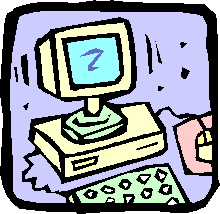
|
-
Secondary
Level:
- Engaging
Technology Tools Projects
-
-
- Let's create a meaningful, engaging,
real-world project! Start by locating some
resources and identifying a learning outcome.
Then, develop an engaging, technology-rich
activity. Finally, assess student
performance.
-
|
Locate Web-Based
Resources
What are you teaching? What resources do you
already have available? In what areas could you use
some additional information, examples, or excitement
to build the learning environment? Start by exploring
the topics we've listed at 42explore.
Seek out resources in your subject area interest.
Pick a couple that you'd like to work with for this
activity.
Bookmark (or favorite)
this site for easy reference.
Identify a Learning
Outcome
Go to the Active
Words page to find more descriptive, active words
for your learning outcome.
Share your active words
and learning outcome with a peer.
Develop Engaging
Activities
Introduction. Draw student interest
with an intriguing introduction. Hook your learners
with a picture, quotation, statistic, or problem that
you know will pique their curiosity.
Activity. Carefully design a project that
will allow students to explore, evaluate, organize,
analyze, and apply information they've found to solve
a problem, formulate something new, or communicate an
idea. Go to the Activity Ideas
page and brainstorm some interesting products that
students could create using the information found on
the Internet.
Tools. Consider the different types of
technology tools you can use to help students develop
creative projects.
Directions. Students need guidelines for
completing your activity. You may wish to provide
step-by-step instructions or a more general list of
requirements. It's helpful for students to see
examples, nonexamples, models, and samples. On the
other hand, you don't want students to simply copy
your suggestions, so your directions need to be
flexible enough to promote unique ideas and
approaches.
Timeline. How long will students be working
on this project? What's realistic? Provide students
with some guidelines for project development.
Identify an engaging
activity and design an project.
Assess Student
Learning
Find out what your students have learned.
Give them a chance to share and reflect. Assessment
isn't about testing and report cards. It should be
about helping you and your students understand where
you've been and where you still need to go to reach
your learning outcomes. Go to Student
Success to identify ideas for assessing student
performance.
- Brainstorm alternative
assessments to match your outcome and
activity.
-
Classroom and
Project Management Tips
- Before you try out your projects. Consider some
Technology Tool Tips.
-
-

- Do
It!
- Project
Development
|
Brainstorm a project. Answer the following
questions:
- What's the goal of the project?
- What problem or issue will be solved
or addressed?
- What's the context of the
project?
- What kind of data needs to be
collected?
- What's the best tool for organizing,
calculating, and analyzing the data?
- What's the specific student
assignment?
- How will student time be spent?
- Do students have the resources they
will need to be successful?
- Will students be working individually
or collaboratively?
- What procedures will be used to
collect, enter, and analyze
information?
- How will student progress be
monitored?
- What will the project look like?
- What end product will be developed to
communicate the results?
- How will the student performance and
project be assessed?
|
Developed by Annette
Lamb, 7/99. Updated
10/99.
|
